Field Guides for the Cayman Islands — a personal list
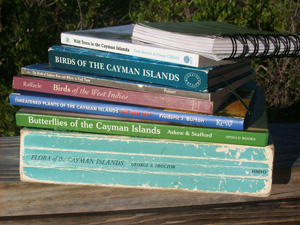
This guide to the field guides includes a “sleeper” — a color- illustrated plant book that costs only $6.99! At the other end of the scale, if you can get it, is the 800 page Flora of the Cayman Islands. Here’s a very personal “library” covering the books in the photo, and a few websites as well.
Sorry not to review books on fishes, corals, seashells and many other fields of natural science. Perhaps another time. And there are whole categories of creatures for which no field guides are available. “Mites of the Cayman Islands”? Only one of dozens more guides we need if we are to understand our country! We value all species, not only “show” species. I’ve skipped several books so this is not a comprehensive list.
To save space, publication details have been omitted. I’ve given enough detail (author, title, ISBN numbers) to enable you to Google. Use normal resources such as the library, Hobbies and Books, the National Trust, the CI government, Kew, Amazon.com as well as Google.
Butterflies of the Cayman Islands by Askew and Stafford. ISBN 978-88757-85-9. This book takes a truly ecological approach. Find a butterfly, identify it from the back color plates, then turn to the specific page. Learn there about your butterfly, its family tree and neighbors on other islands. Turn to the 10-page table “Larval Food-plants and Nectar Flowers” and discover our Cayman trees and plants, keyed for their usefulness not to humans (“this wood was burned to keep away mosquitos”) but to our butterflies! Enter a butterfly-centered world! This is a book written by two experts who love their subjects. The smallness of our land allows detail not possible in reference books for bigger countries with more butterfly species.
Camana Way/Plants shows no author and has no ISBN code. But for $6.99 you should get a copy! It is the handiest illustrated compendium available to us, either in print or on the web. Contact the company to buy a copy, Camana Bay.com. It is indexed only by scientific names — a good incentive to learn them! The company has tried to re-create each of our native landforms in a George Town boulevard, from beach through lowland to higher ground. At great expense they have planted the shrubs and trees, mostly native, which represent each zone. Take this stroll! The irony is that real landscape can be purchased at perhaps one-tenth the cost on any of the three islands, with no maintenance cost! Perhaps the same company will do this, and protect some native land for all time.
Wild Trees of the Cayman Islands by Fred Burton, illustrated by Penny Clifford, ISBN 978-14276-2168-9 is an excellent reference to the native trees one is most likely to look up, and a few such as mango which are more-or-less naturalized. It comes with a key, best employed by two people. You’ll know you’re getting up on your trees when you discover the ones you’re trying to identify are categorized as shrubs and therefore not included! This is a friendly, handy text with wonderful drawings.
Threatened Plants of the Cayman Islands: The Red List by Fred Burton, ISBN 978-1-84246-220-1. This is a technical book, beautifully produced, following the rules for categorizing degrees of endangerment of plant species. One hopes collectors will not exploit it and further endanger them! A great contribution is the list of our native plant species and varieties, almost 400, by family, noting their occurrence on each of the three Cayman Islands. Being of recent publication (2000) the names are more current than in the 1984 edition of Proctor’s Flora of the Cayman Islands. The accompanying disc gives the current vegetation classification for the Cayman Islands, updating the classification by Brunt which is included in Proctor’s Flora.
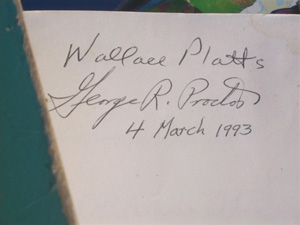
Flora of the Cayman Islands by George R. Proctor, ISBN 0-11-242548-8. The second edition is sitting over at Kew awaiting publication. We need to chase it. To call this book a life’s work is misleading. It is OUR lives that have been changed because of it, not only those of us lucky enough to have spent hours in the bush with Dr. Proctor but others who never had the chance. My copy is well thumbed but awakens me afresh every time I refer to it. Each family and species is set in its world context as well as its Cayman setting. One learns about the world of nature, of “the world’s ultimate adaptive machine” from these pages. In a way, those of us who have followed have been mining his work. When we share our hard-won knowledge we are following his generous example. He kept the details and the nomenclature in his mind even to his older years, like printer’s proofs. The index of Caymanian common names helps us “get into” this book, and has helped to standardize the names for all our benefit. These names show the regard he had for the common man, the men and women he met during his decades of research in our beautiful bush. Truly an inspiration, this book should now be updated with the hundreds of species he recorded since 1984. We need our Flora, and it will be his no matter how many young editors must be called upon for specialist contributions.
One has met Roger Tory Peterson and Merlin Tuttle. Our Dr. Proctor has not had the international influence of these titans. But thanks to him, our trees and plants are as well counted and described as those of any other country in our Greater Antilles, or indeed in other, perhaps more famous natural areas in the world.
In 1984 Proctor predicted that many more plants would be found. (His Flora describes 601.) This has come to pass as we will see with his revised Flora, which we pray will be released before his death. “On the other hand, there is real danger that the building of new roads, hotels, and housing settlements will bring about the total extermination of many interesting or unique plant species unless enough representative habitats can be saved from the blulldozers.” This is the torch he has passed along to us.
2ND EDITION OF PROCTOR’S FLORA OF THE CAYMAN ISLANDS
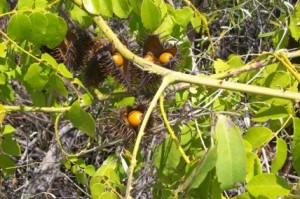
The second edition, 2012 is a tremendous achievement and step forward, accomplished by the aged doctor with assistance by several experts and good people. The main benefit of this edition is the inclusion of color photos. There are some 400. For botanists both amateur and professional the great event is the addition of about 100 species found in the Cayman Islands but not recorded in the first edition. The definitive book is now in our hands.
More work remains to be done! Of importance to Cayman Brac is the need to include 10 plants, and probably several more, which are known to exist and even thrive on this island but are not shown to live here in the official texts – the second edition of Proctor and the table at the end of the Red List reference book, reviewed here. Ten such plants spring to mind. They are
| Satinwood | Zanthoxylum flavum |
| Poison tree | Metopium toxiferum |
| Soapberry | Sapindus saponaria |
| Kapok | Ceiba pentranda |
| Jamaican Forget-Me-Not | Duranta erecta |
| Tillandsia: this species: | Tillandsia setacea |
| Yellow nicker | Caesalpina wrightiana |
| Yellow nicker | Caesalpina intermedia |
| Boxwood | Buxus bahamensis |
| Vanilla orchid | Vanilla claviculata |
And certainly, though it must be re-found and confirmed, at least one species of wild cucumber.
Birds of Cayman Brac and Where to Find Them, by Keith Prescott. ISBN 976 8104 99 6. As far as I know this is the first book in history solely dedicated to Cayman Brac, ever published. It was published in 1997 after printing delays. A few maps may be out of date but the text is as good as ever. How about this description of the Rainbird’s call (Mangrove Cuckoo): “… a rapidly repeated “gaw” sounding something like a cross between an insane laugh and a croaking frog.” Highly recommended for any Brac-based birder, for its local knowledge and personal touch. There are no bird illlustrations so add the following companion books to your reference shelf.
Birds of the Cayman Islands (1995 edition) by Patricia Bradley, ISBN 976-8052-10-4. A few years have elapsed since first publication in 1985, so we can call Mrs. Bradley the grande dame of Cayman Islands ornithology. (The second edition came out in 1995.) She is one of the modern pioneers responsible for putting excellent Cayman Islands field guides in our hands and she retains her stature as our leading bird and eco-tourism expert. Since only the birds that breed here are illustrated, this book must be used in conjunction with one of the standard North American field guides, or a Caribbean guide such as Raffaele (see these reviews). IMPORTANT: See review of Mrs. Bradley’s NEW Birds of the Cayman Islands, below.
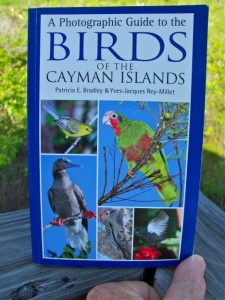
Different birders need different books, so all those reviewed on these pages are legitimate. Prescott for example gives great detail on Cayman Brac. The Audubon reference gives more comparative drawings of wing patterns and so on, James Bond introduced us to the Caribbean birds while Peterson’s system allowed birders to identify from life, a big step up from shooting them for identification! So joining our library (but it won’t rest long on the shelf) we must say Welcome to the 2013 Birds of the Cayman Islands by Bradley and Rey-Millet!
Although I’m not reviewing it here, you should check out Birds of Jamaica, a sister book. Published in 2009 it provides for each bird a map and a “box” to convey some of the information in a handy fashion. Its photos are labeled for locale (at least for country — several are from the Cayman Islands). Like Birds of the Cayman Islands this one, the sister book is the perfect reference for its country.
Birds of the West Indies by Raffaele et.al ISBN 0-691-11319-X. This is but one of the field guides that could be recommended as the companion to the above two bird books. This one “steals” the title from the classic reference by James Bond (1960). Other than blithely changing the name of the Cuban Parrot, the book seems very reliable. (Canada Goose, you should beware!) It is compact, well-bound on good quality paper and the warbler plates are particularly clear. (See “note on taxonomy and nomenclature” at the end of this article.)
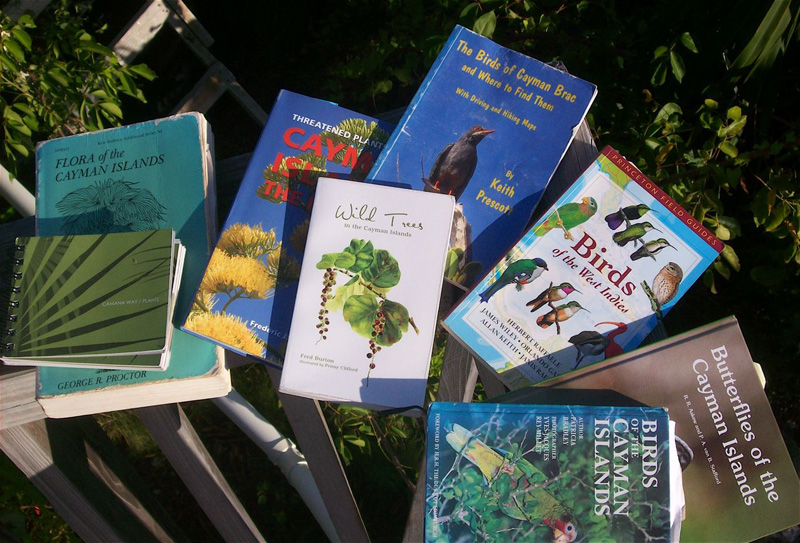
WEB-BASED REFERENCES
We can now take our computers into the field. In the eastern states of the USA, your iPod can be loaded with tree leaf shapes to identify trees as you saunter through the forest.
The following Internet sources have been valuable to me. Not all are friendly, not all are updated regularly, and not all are “vetted” like the published references cited above. Use with discretion, like the very blog you’re reading at the moment. Some sites work only with scientific names, which is fine if you know them.
Cayman Wildlife Connection, particularly this one:![]()
www.caymanwildlife.org/images/plantimages/Mini-Woodlands9-05.pdf by Ann Stafford
![]() National Trust for the Cayman Islands, particularly the virtual herbarium, maintained by Fairchild Tropical Gardens:
National Trust for the Cayman Islands, particularly the virtual herbarium, maintained by Fairchild Tropical Gardens:
www.virtualherbarium.org/vh/caym/default.htm
![]() The Royal Gardens at Kew:
The Royal Gardens at Kew:
http://www.kew.org/science/directory/rojects
![]() Florida International University:
Florida International University:
http://gislab.fiu.edu/treesofMiami/trees/scientific_names.html
A NOTE ON TAXONOMY AND NOMENCLATURE
Fiddling with well-established common names is not typical of bird nomenclature, which is stabilized by the AOU (American Ornithologists’ Union). Common names have become quite standardized since Roger Tory Peterson’s guides, and this facilitates exchange of information among the legions of bird enthusiasts. The same is NOT true of the plant study community, many of whom are garden club members who themselves love to fiddle with species. Their impact on the natural world, like the impact of public zoos and the pet industry, is problematic. All three may contribute to the endangerment of plant and animal species, sometimes occasioning no action and other times, heroic efforts to bring them back from the brink of extinction! Lacking the stability of hosts of amateur naturalists, the scientists involved seem to tinker with the scientific names! How else to explain that in a mere 20 years I’ve seen four “scientific names” for one species of cactus ! Part of the problem may lie with in-fighting, over-analysis, jealousies and the search for fame by the scientists involved. A related problem may lie in unfounded belief in mitochondrial DNA (mtDNA) as a test of species status. One now finds many “species” that will happily mate with other “species” and produce totally viable offspring, fully able to carry out the full reproductive cycle. Bat students have been among the first to question mtDNA, but the “splitters” are still winning the battle over the “lumpers” in naming new species where no new species exist.
If the same criteria were applied to dogs and cats each breed would be called a species. Dalmatians are further removed from poodles than many so-called species in nature. Someone said the Brac parrot may be a candidate for species consideration. Hogwash! There’s a role to be played in these discussions by the community of amateur naturalists. Let’s speak up!
